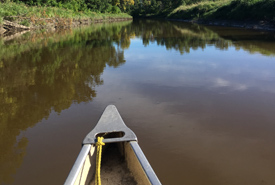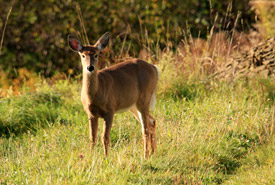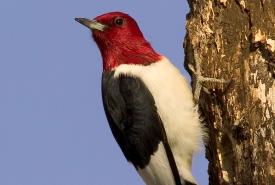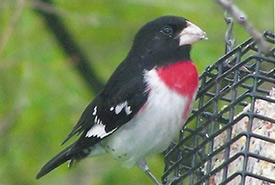Nature's never boring: Paddling the Rat River

Lisa paddling along the Rat River (Photo by NCC)
Growing up, my interest in the outdoors stemmed from camping trips with my family and backroad Sunday drives, led by my dad, in hopes of finding a secluded fishing hole.
Today, I’ve made a little home along the Rat River, a small tributary of the mighty Red River in Manitoba. Living along a river has opened up a whole new wilderness for me. It has turned my backyard into kilometres of exploration and adventure.
Each new season along the Rat River brings anticipation. In winter, my partner and I walked and skied down the river, where we were hidden from the cold prairie winds and soothed by the surrounding intense quiet. We became allies with the white-tailed deer, using each other’s footprints as a means to better traverse the knee-high snow on top of the river ice.

White-tailed deer (Photo by Dean Mullin)
In spring, we anxiously waited to witness the river come alive. When the riverbanks swelled, it brought the river closer to our house and we were able to witness a lone beaver passing through our water-logged yard at dusk. Spring migrations brought multiple red-bellied woodpecker sightings. A regular morning walk to open the chicken coop was rewarded with the sighting of a great blue heron soaring just above the water, the bird following the river and its bends.

Red-headed woodpecker (Photo by D. Fast)
As the water receded, canoe season returned. With the sound of the paddle lightly slicing the water, we were once again able to quietly manoeuvre the Rat River. We followed mallards, spotted white-tailed deer and coyote on the banks, passed snapping turtles on logs and followed birds up close with our binoculars.
The most impressive sighting was a red-headed woodpecker, a threatened species according to the Committee on the Status of Endangered Wildlife in Canada. I spotted its stunning red head against its black and white body as it foraged for food, flying between old tree stumps along the riverbank. As we turned one of the many bends along the river, we scared a gaggle of Canada geese and heard the uproar of their large wings hitting the water as they flew off.
Now into summer and with the river low, we admire what the land has to offer. Canada anemone coats the bottom of the riverbank forest, and we keep an eye out for the rare ironweed plant that is rumoured to have been previously spotted very close to our bend in the river.

Strikingly beautiful male rose-breasted grosbeak at the feeder eating suet. (Photo by Dr. Henry Barnett)
But summer proves to us that we don’t have to go far from the house to connect with nature. As our garden fills out, the purple martins keep watch above and make their presence known with their distinct rolling song. Binoculars are scattered throughout the house and we have sighted yellow-belled sapsucker, a rose-breasted grosbeak, eastern bluebird and purple finch, to name a few. The spine of our bird book is bent from use and being left permanently open on the kitchen table.
Fall will hopefully bring more trips down the Rat River, and new plants and animals to see.
One thing is for sure — regardless of the season — nature’s never boring.


